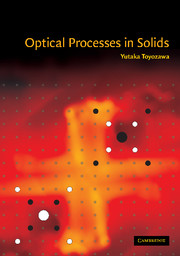Book contents
- Frontmatter
- Contents
- Preface
- Acknowledgments
- List of principal symbols
- 1 Radiation field
- 2 Quantum mechanics
- 3 Interaction of radiation with matter
- 4 Electronic vs. nuclear motions and the optical spectra of localized electrons in solids
- 5 Lattice vibrations
- 6 Electric susceptibility and dielectric constant
- 7 One-electron states in solids
- 8 Excitons
- 9 Polaron and the self-trapped state
- 10 Optical spectra of exciton in the phonon field Overview
- 11 Higher-order optical processes
- 12 Inner-shell excitation
- 13 Photo-induced structural changes
- 14 Light, matter and life (A scenario for the origin of life and its evolution)
- Appendix 1 Derivation of exciton Hamiltonian from many-body Hamiltonian
- Appendix 2 Transient spectra for second-order optical processes
- References (by chapter)
- Subject index
11 - Higher-order optical processes
Published online by Cambridge University Press: 10 December 2009
- Frontmatter
- Contents
- Preface
- Acknowledgments
- List of principal symbols
- 1 Radiation field
- 2 Quantum mechanics
- 3 Interaction of radiation with matter
- 4 Electronic vs. nuclear motions and the optical spectra of localized electrons in solids
- 5 Lattice vibrations
- 6 Electric susceptibility and dielectric constant
- 7 One-electron states in solids
- 8 Excitons
- 9 Polaron and the self-trapped state
- 10 Optical spectra of exciton in the phonon field Overview
- 11 Higher-order optical processes
- 12 Inner-shell excitation
- 13 Photo-induced structural changes
- 14 Light, matter and life (A scenario for the origin of life and its evolution)
- Appendix 1 Derivation of exciton Hamiltonian from many-body Hamiltonian
- Appendix 2 Transient spectra for second-order optical processes
- References (by chapter)
- Subject index
Summary
Nonlinear responses and multiphoton processes
The invention of the laser – a light source device making use of “light amplification by stimulated emission of radiation” as its working principle – brought about revolutionary developments in the spectroscopic study of matter. The high intensity, monochromaticity, coherence and directivity of this new light source, have all contributed to the development of adaptable technologies which can meet a variety of the high-grade requirements in spectroscopic research. In particular, the intensity can be made high enough to give rise to nonlinear responses of matter up to quite high orders. Fortunately, these responses can be well separated into successive orders, on the basis of their dependence on the amplitude of the incident electromagnetic field and their characteristic frequency dependence, unless the intensity is too high. In fact, the response can be expanded in a power series in the field, the good convergence of which originates primarily from the smallness of the radiation–matter coupling constant compared to other interactions within the matter.
To make the statement more definite, we start with the lowest-order nonlinear response. Consider two independent electromagnetic waves, E1exp(ik1 · r – iω1t) and E2exp(ik2 · r – iω2t) propagating in the same direction (k1 ∥ k2) within matter with refractive index n(ω) as defined by (1.2.5). Ignoring their spatial dependence for the moment, one can consider that part of the polarization which is induced as a second-order response to E1 and E2 of the form (cross terms)
corresponding to the linear response given by (6.1.29).
- Type
- Chapter
- Information
- Optical Processes in Solids , pp. 239 - 283Publisher: Cambridge University PressPrint publication year: 2003

